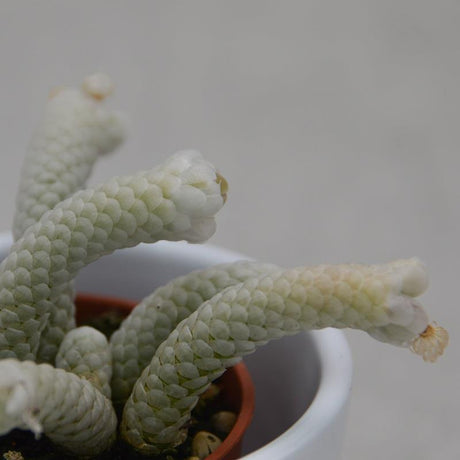Avonia
Origin
The genus Avonia belongs to the family Portulacaceae. The approximately 20 species belonging to it were formerly part of the genus Anacampseros, but were reclassified into their own genus in 1994. Their original home is in South Africa.
Appearance
The succulents form a caudex that can reach 5 cm to 10 cm in diameter. Avonia has green leaves covered with a layer of small, papery, white stipules. These fit tightly around the plant's branches and protect them from drying out. The flower is very small, white, cream-colored or purple, and lasts only a very short time in most species.
Care
Location: This genus should be placed in a sunny and bright spot. A lot of light is necessary to bring the succulents into bloom.
Substrate: A mixture of cactus and succulent soil with mineral components such as pumice, gravel or vermiculite is suitable as a substrate. The substrate should be loose and permeable so that no water remains in the soil, but can drain well. They also feel comfortable in pure pumice.
Watering: With Avonia plants, it's better to water too little than too much, and only when the substrate is dry. Succulents do not tolerate waterlogging, so the water should drain through the drainage hole in the bottom of the pot or be emptied after a few minutes if there is no hole.
Fertilizer: During the growing season, you can fertilize approximately once a month with cactus and succulent fertilizer. During the dormant period, succulents do not require fertilizer.
Summer/Winter: Avonia can spend the summer outdoors after being gradually acclimated to the sun. If temperatures drop below 10°C, the succulent should be brought back indoors. A location with 15°C is optimal in winter. During this time, fertilizing should be stopped and watering should be infrequent.
Popular species
Avonia papyracea: This succulent has a rosette-shaped growth habit. Its flower is white or cream-colored, but usually only lasts for a few hours. The plant can reach a height of 10 cm.
Note: The genus Avonia is generally non-toxic, but we cannot guarantee compatibility with animals.
- Featured
- Best selling
- Alphabetically, A-Z
- Alphabetically, Z-A
- Price, low to high
- Price, high to low
- Date, old to new
- Date, new to old
FiltersFilter & Sort
- Regular price 6,80 €Unit price /Unavailable
Herkunft
Die Gattung Avonia gehört zur Familie Portulacaceae. Die circa 20 dazugehörigen Arten waren früher Teil der Gattung Anacampseros wurden 1994 aber in eine eigene Gattung umgruppiert. Ihre ursprüngliche Heimat ist in Südafrika.
Aussehen
Die Sukkulenten bilden einen Caudex, der 5 cm bis 10 cm Durchmesser erreichen kann. Avonia hat grüne Blätter, die von einer Schicht weißer kleiner, papierähnlicher Nebenblätter bedeckt sind. Sie schmiegen sich eng um die Zweige der Pflanze und schützen sie vor Austrocknung. Die Blüte ist sehr klein, weiß, cremefarben oder lila und hält bei den meisten Arten nur für eine sehr kurze Zeit.
Pflege
Standort: Diese Gattung sollte an einem sonnigen und hellen Platz stehen. Um die Sukkulenten zum Blühen zu bringen ist viel Licht notwendig.
Substrat: Als Substrat bietet sich eine Mischung aus Kakteen- und Sukkulentenerde an mit mineralischen Bestandteilen, wie Bims, Kies oder Vermiculite. Das Substrat sollte locker und durchlässig sein, damit kein Wasser in der Erde stehen bleibt, sondern gut ablaufen kann. Auch in reinem Bims fühlen sie sich wohl.
Bewässerung: Bei Avonia Pflanzen gilt, lieber zu wenig als zu viel gießen und immer erst dann, wenn das Substrat getrocknet ist. Sukkulenten vertragen keine Staunässe, deswegen sollte das Wasser durch das Drainageloch im Boden des Topfes ablaufen oder nach einigen Minuten ausgeleert werden, wenn kein Loch vorhanden ist.
Dünger: Gedüngt werden kann in der Wachstumsphase ungefähr einmal im Monat mit Kakteen- und Sukkulentendünger. In der Ruhephase benötigen Sukkulenten keinen Dünger.
Sommer/Winter: Den Sommer kann Avonia im Freien verbringen, nachdem sie schrittweise an die Sonne gewöhnt wurde. Wenn die Temperaturen unter 10°C fallen sollte die Sukkulente wieder nach innen gebracht werden. Im Winter ist ein Standort mit 15°C optimal. In dieser Zeit sollte nicht mehr gedüngt und nur selten gegossen werden.
Beliebte Arten
Avonia papyracea: Diese Sukkulente hat einen rosettenförmigen Wuchs. Ihre Blüte ist weiß oder cremefarben, hält aber meist nur für wenige Stunden. Die Pflanze kann eine Wuchshöhe von 10 cm erreichen.
Hinweis: Die Gattung Avonia ist grundsätzlich ungiftig, aber eine Garantie für die Verträglichkeit mit Tieren können wir nicht übernehmen.
Let customers speak for us
from 434 reviewsDiese Pflanze sieht sehr edel aus und bereichert meine kleine Sammlung ungemein. Die Ware kam sehr gut verpackt bei mir an.

Sehr schöne und gesunde Pflanze.
Die tillandsien von pasiora machen Lust auf mehr. Hier kaufe ich immer wieder gerne.

Die Pflanze gefällt mir auf Grund ihres speziellen Wuchses außerordentlich gut.

Schnelle Lieferung
Gute Verpackung
Sehr gute Pflanzen

Merci pour l'envoi. Tout était parfait et rapide

Pflanzen waren fast alle wie beschrieben. Schnelle Lieferung, trotz einfacherVerpackung sind alle gut angekommen. Alles top, werde wieder bestellen.

Reibungsloses Einkaufen in einem schönen Shop mit Kompetenz. Es ist mir jedes Mal eine Freude.
Wunderschöne kräftige Pflanzen mit feinen Blättern. Ich werde mir einen Bonsai daraus gestalten.

Diese Pflanze sieht toll aus, ist sehr gesund, wie alle Pflanzen, die ich von Pasiora erhalten habe. Kann man wirklich empfehlen,dort einzukaufen.

Sehr schöne,blühende Pflanze. Wie immer eine top Qualität.

Get 10% off your first order.
+ Exclusive tips, care guides and access to rare plants.








